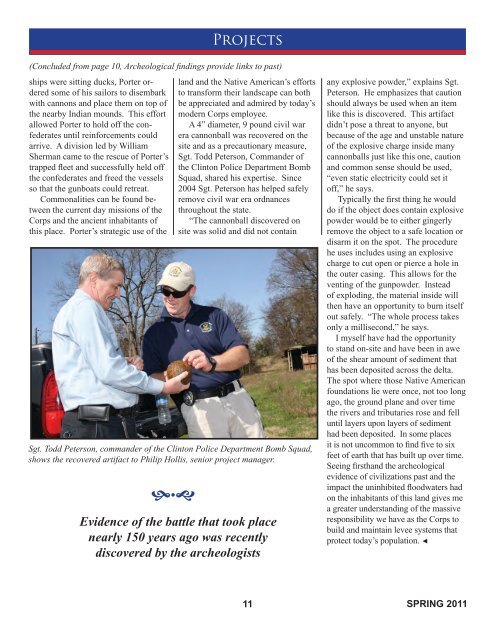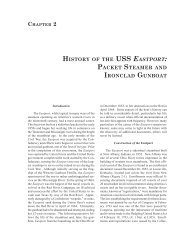Spring 2011.pdf - Vicksburg District - U.S. Army
Spring 2011.pdf - Vicksburg District - U.S. Army
Spring 2011.pdf - Vicksburg District - U.S. Army
You also want an ePaper? Increase the reach of your titles
YUMPU automatically turns print PDFs into web optimized ePapers that Google loves.
ships were sitting ducks, Porter ordered<br />
some of his sailors to disembark<br />
with cannons and place them on top of<br />
the nearby Indian mounds. This effort<br />
allowed Porter to hold off the confederates<br />
until reinforcements could<br />
arrive. A division led by William<br />
Sherman came to the rescue of Porter’s<br />
trapped fleet and successfully held off<br />
the confederates and freed the vessels<br />
so that the gunboats could retreat.<br />
Commonalities can be found between<br />
the current day missions of the<br />
Corps and the ancient inhabitants of<br />
this place. Porter’s strategic use of the<br />
Projects<br />
(Concluded from page 10, Archeological findings provide links to past)<br />
land and the Native American’s efforts<br />
to transform their landscape can both<br />
be appreciated and admired by today’s<br />
modern Corps employee.<br />
A 4” diameter, 9 pound civil war<br />
era cannonball was recovered on the<br />
site and as a precautionary measure,<br />
Sgt. Todd Peterson, Commander of<br />
the Clinton Police Department Bomb<br />
Squad, shared his expertise. Since<br />
2004 Sgt. Peterson has helped safely<br />
remove civil war era ordnances<br />
throughout the state.<br />
“The cannonball discovered on<br />
site was solid and did not contain<br />
Sgt. Todd Peterson, commander of the Clinton Police Department Bomb Squad,<br />
shows the recovered artifact to Philip Hollis, senior project manager.<br />
Evidence of the battle that took place<br />
nearly 150 years ago was recently<br />
discovered by the archeologists<br />
11<br />
any explosive powder,” explains Sgt.<br />
Peterson. He emphasizes that caution<br />
should always be used when an item<br />
like this is discovered. This artifact<br />
didn’t pose a threat to anyone, but<br />
because of the age and unstable nature<br />
of the explosive charge inside many<br />
cannonballs just like this one, caution<br />
and common sense should be used,<br />
“even static electricity could set it<br />
off,” he says.<br />
Typically the first thing he would<br />
do if the object does contain explosive<br />
powder would be to either gingerly<br />
remove the object to a safe location or<br />
disarm it on the spot. The procedure<br />
he uses includes using an explosive<br />
charge to cut open or pierce a hole in<br />
the outer casing. This allows for the<br />
venting of the gunpowder. Instead<br />
of exploding, the material inside will<br />
then have an opportunity to burn itself<br />
out safely. “The whole process takes<br />
only a millisecond,” he says.<br />
I myself have had the opportunity<br />
to stand on-site and have been in awe<br />
of the shear amount of sediment that<br />
has been deposited across the delta.<br />
The spot where those Native American<br />
foundations lie were once, not too long<br />
ago, the ground plane and over time<br />
the rivers and tributaries rose and fell<br />
until layers upon layers of sediment<br />
had been deposited. In some places<br />
it is not uncommon to find five to six<br />
feet of earth that has built up over time.<br />
Seeing firsthand the archeological<br />
evidence of civilizations past and the<br />
impact the uninhibited floodwaters had<br />
on the inhabitants of this land gives me<br />
a greater understanding of the massive<br />
responsibility we have as the Corps to<br />
build and maintain levee systems that<br />
protect today’s population. ◄<br />
SPRING 2011





